Cables and connectors
The Seasonic SSR-360GP is equipped with
cables and connectors as follows:
·
One mainboard cable with a 24-pin connector (54
cm)
·
One CPU cable with a 4+4-pin connector (57 cm)
·
One graphics card cable with a 6-pin connector
(60 cm)
·
One cable with three PATA power connectors
(45+12+12 cm)
·
One cable with two SATA power connectors (44+15
cm)
·
One cable with two SATA power connectors (36+15
cm)
Coming with the
PSU is a 15cm Y-shaped adapter from a PATA power connector port to two
floppy-drive plugs.
The number of connectors is very impressed
with a PSU with such a modest wattage. The 4+4-pin CPU plug is rare to see in
products of this class, separated from the connector of the graphics card.
We can recognize some of unreasonable SATA
power connectors; they seem to be too few for some PC configurations. You
cannot connect more than two HDDs (if you get an optical drive) unless you use
power adapters. But most users will not notice this issue.
The slightly short CPU power cable hardly
causes any restrictions because this PSU is used in a mATX or ATX case in which
this cable is long enough to be hidden in the mainboard.
Technical specifications
Power management
·
Rated power, W: 360
·
AC input voltage, V: 90-264
·
AC input frequency, Hez: 50-60
·
Combined power (+3.3 V), W: 80
·
Combined power (+12 V), W: 360
·
Combined power (+5 V), W: 80
·
Combined power (-12V), W: 3.6
·
Combined power (+5 VSB), W: 10
·
Max output current (+3.3 V), A: 12
·
Max output current (+5 V), A: 16
·
Max output current (-12V), A: 0.3
·
Max output current (+5 VSB), A: 2
Cooling system
·
Diameter, fan, mm: 120
Connection
·
Number of SATA power connectors: 4
·
peripheral power connectors (Molex) (4 feet): 3
·
PCI PCI Express power connectors (6 feet): 1
Product size
·
Width, mm: 150
·
Depth, mm: 140
·
Height, mm: 86
Certificate,
80 PLUS certification
·
80 PLUS Gold
Color of
product
·
Black
The ability to
combine the two power bands +5 V and +3.3 V is low at only 80 watts, but even
if we have a look at the top-end modern PCs that hardly consume up to 50 watts
from them, that is true for a 360W PSU. Also keep going on the current trends,
the PSU can generate its full output power with +12V rail, which is the most
important source of power for the modern computers.
The standby source can be determined to
load up to 2 amperes. It's not much, but enough for a PSU with the consumed
wattage like that.
And we may remind you once again that the
Seasonic SSR-360GP comes with 80 PLUS Gold standard.
UPS compatibility
Operating with APC SmartUPS SC 620, this
PSU was stable when loading up to 360 watts when being charged by the
mainboards, but could not move to the UPS’s batteries, even at 280 watts.
Voltage stability
The manufacturer promises that the voltage
fluctuates in the range of about 3% or less and it is the same in reality.
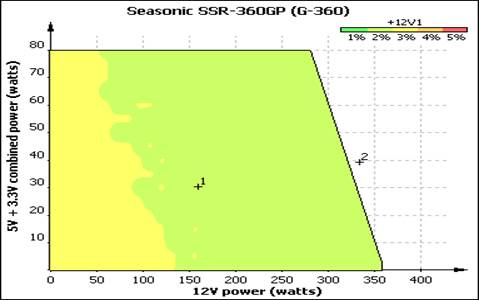
The
voltage fluctuation
The most important +12 V voltage fluctuates
in the range of 3% at average loads and by less than 2% at loads above 130
watts.
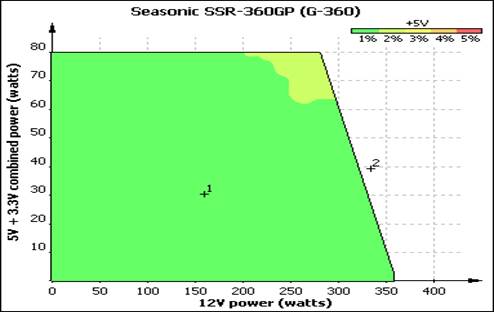
The
voltage stability
The +5 V power strip offers exemplary
stability. Its voltage is almost always in the range of 1% and only goes beyond
that limit when there is high load on each of the power strip, which seems to
be an unrealistic scenario.
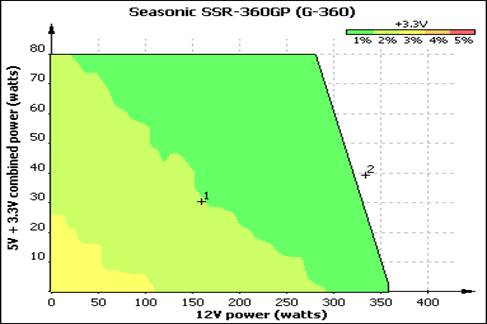
The
voltage stability
The +3.3V voltage is less than 2% compared
to the required level when each power strip loads up in a low level. At higher
level, this voltage remains stable even.
Generally, the Seasonic SSR-360GP works
very well in testing this stability.
Output voltage ripples
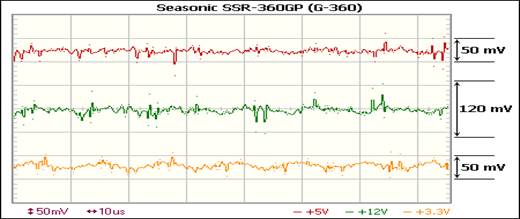
The
graph describes the output voltage.
The ripple-shaped graph describes the fact
that the output voltage is higher than with Seasonic’s more expensive PSUs but
still is appropriate to the requirements about a wide margin.
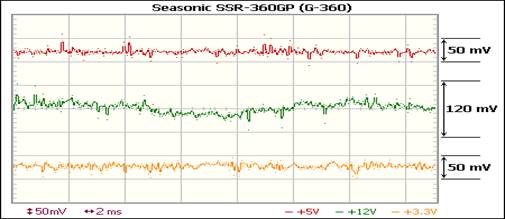
The
graph describes the output voltage.
The same thing takes place with the
low-frequency ripples: it's just a bit stronger than the +12V rail but weaker
on the +3.3V rail.
Temperature and noise
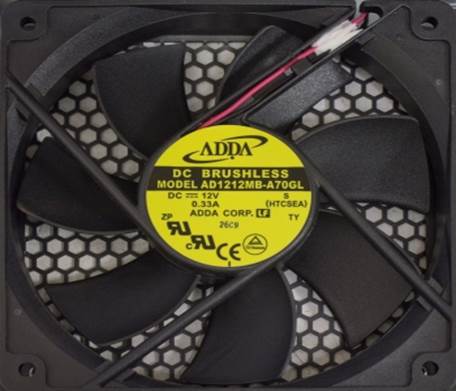
The
PSU’s fan
The Seasonic SSR-360GP is cooled by a 120mm
fan of ADDA. It is the AD1212MB- A70GL model with a determined speed of 2050
RPM.
Although the fan itself does not produce
unwanted sounds at all, the honeycomb network of Seasonic is very proud of
(mentioned about it in the section of the product box) has created a greater
obstacle on the path of the air flow than the conventionally standard wire
grids, which only makes the fan produce the sounds that can be heard at 1100
RPM and higher.
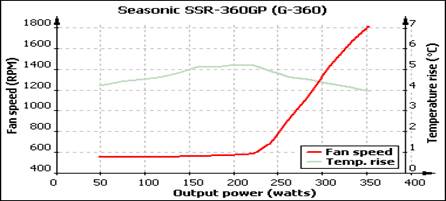
The
graph depicts the noise level and temperature
The initial speed of the fan is only 550
RPM. It is maintained until reaching two-thirds of the PSU’s full power but
then the fan’s speed is very fast, which is also characteristic of many
Seasonic PSUs. The practical speed increases by a triple number (from 600 to
1800 RPM) when the input power increases to a 100-watt range of loads.
So the Seasonic SSR-360GP is virtually
silent when running up to 250 watts, but very loud if it operates with above
300 watts.
Efficiency and power factor
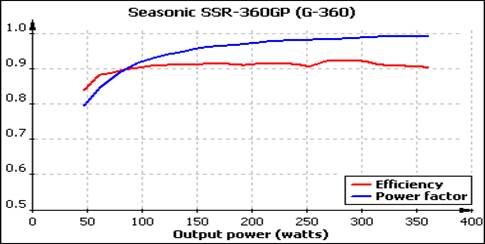
The
graph of efficiency and power factor
In the reference levels of 20%, 50% and
100%, the Seasonic SSR-360GP achieves corresponding efficiency that is 88.8%,
91.4% and 90.3%. It reaches a maximum efficiency of 92.5% at a load of 270
watts.
The consumed power factor is over 99% at
high loads, which is similar to what the manufacturer has promised.
Standby source
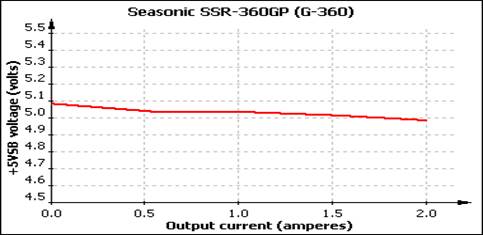
Standby
source
The standby voltage is always stable at
high loads in the range from 0 to 2A.